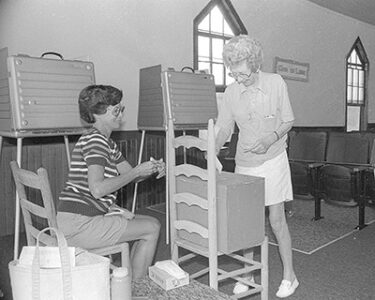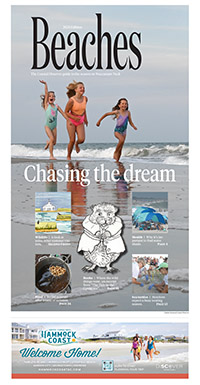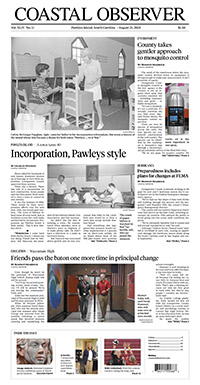Pawleys Island
Forty years ago, a town was born

Plans called for hundreds of new homes. Residents showed up at hearings to voice their opposition. Georgetown County approved them anyway.
There was a lawsuit. There was talk of a moratorium on new construction. Some people said the Waccamaw Neck needed to form a town to control its own destiny.
It was the summer of 1984. There would be three incorporation efforts over the next year. Only one would gain traction. The town of Pawleys Island turns 40 next week, just as residents across the creek make another bid to incorporate. Proponents say Pawleys Island is their model. This is how Pawleys did it.
“Whenever I come back from Myrtle Beach, I always say one thing: Thank God for Pawleys,” Bill Hancock, the president of the Pawleys Island Civic Association, said that summer.
He didn’t like the idea of forming a town. He remembered when islanders went to Marlow’s store on Highway 17 to make phone calls. He didn’t have a television or a radio in his beach house.
But Hancock was concerned about growth and he was concerned that folks in the Litchfield area would try to form a town that would include Pawleys Island.
And something else happened that summer. South Carolina implemented a 2 percent tax on short-term rentals. On an island where most of the 500-plus homes were summer rentals, the tax could generate enough money to operate a town, particularly if the services were limited. It wouldn’t need a municipal property tax.
The civic association board agreed to put the idea up for a vote of the membership at its annual meeting over the Labor Day weekend. More than 200 people packed into the Pawleys Island Chapel to discuss incorporation.
“There are a lot of people who talk about it,” Don Wray, executive director of the S.C. Municipal association, told them. Some find out it isn’t practical when they create the feasibility study required by state law. Others can’t convince the voters.
Association members were concerned about rising land values. A vacant 60-foot-lot had sold earlier for $325,000, equal to just over $1 million today. They worried about cottages being converted to time-share units and that a proposal to replace septic tanks with public sewer would allow more multi-family development like Pawleys Pier Village.
“Pawleys Island is in the historic register. It won’t stay the same,” Betty Fogel said.
Moving forward
The members voted 171 to 15 to move forward with a petition to the S.C. Secretary of State and a feasibility study. Another 25 said they wanted more information.
The association quickly gathered signatures from 200 property owners and 60 of the 80 registered voters. (State law was later changed so only registered voters could petition for incorporation.)
The civic association’s attorney, Reese Daniel, was handling the application. Before moving forward with a feasibility study, the incorporation plan hit a snag.
The State Tax Commission took the position that the accommodations tax that the new town was counting on for revenue should be returned to the place the rent was paid, not where the rental property was located. With no rental offices on the island, Pawleys Island’s tax revenue would go to Georgetown County.
“The new accommodations tax is the largest factor in the move to incorporate,” Daniel said.
Pawleys Island would wait until the General Assembly convened in January. With bills to tweak the tax law pre-filed, the civic association commissioned a feasibility study from the Waccamaw Regional Planning and Development Council, now known as the council of governments.
Aside from public utilities, the town got police protection from the sheriff’s office and fire protection from Midway Fire Department, which collected a 5 mill property tax on the island and the mainland. The state owned just over 5 miles of paved roads on the island. The county owned the public beach walkways and two boat landings.
“It is assumed that the present level of services and the service providers will remain unchanged through the use of inter-local agreements and/or service contracts,” the study said.
It estimated revenue of $40,000 from the accommodations tax and just over $12,000 from state and federal revenue sharing.
Daniel said the new town would consider hiring a building inspector and police. Fines from code and traffic enforcement could bring in additional revenue. A business license was another option, but he said a local property tax would be a “last source.”
Litchfield follows
As the Pawleys Island Civic Association was reviewing the study, residents in the Litchfield Beaches and Litchfield Country Club launched an incorporation effort. That came as three residents delivered a petition with over 1,000 signatures to Gov. Dick Riley calling for a environmental study for the Waccamaw Neck and a moratorium on zoning changes until the study could be completed.
“For the long haul, you need to sit down with county council,” Riley told them, but he asked the Water Resources Commission to review the request.
At the same time residents were petitioning the governor, the county was reviewing requests for 3,950 dwellings at Willbrook Plantation and 853 at the former True Blue plantation, which was being renamed Heritage Plantation.
The Pawleys Island incorporation petition went to Secretary of State John Campbell in June. Daniel said he timed the submission so that a referendum could be held around Labor Day. He expected Campbell to make a decision within 60 days and the referendum would be held within 90 days of that. But the election would also require approval from the U.S. Department of Justice under the Voting Rights Act, which had a 60-day review window.
Campbell approved the petition in a week and appointed a five-member commission to conduct the election. They set Aug. 27 for the vote.
Stacy Clardy, who was commission chairman, pointed out that incorporation had been talked about for 30 years. He favored forming a town “to control the growth on the island and keep it as it is – the island as a family beach.” But he said the commission’s goal was to make sure everyone was heard and informed.
As Pawleys Island moved toward a vote, the incorporation effort in Litchfield collapsed. The country club POA withdrew its support, citing a fear that a town would lead to increased taxes.
There were only 72 registered voters on the island when the vote was scheduled. Many property owners had talked about changing their voting address when the issue was first discussed by the civic association. The state law about residency was, and remains, loose. As long as a person isn’t registered to vote in more than one place, intent is the key factor.
When registration closed a month before the election, there were 121 voters on Pawleys Island.
The debate begins
The fear that a new town would bring new taxes was central to the debate over incorporation, which was carried out at a forum, in letters to the editor and advertising.
“I have seen the island develop from oil lamp and pitcher-pump days. What I see today I like,” W.W. “Billy” Doar said in a letter.
He first came to Pawleys as an infant in 1903 and built his own house there 45 years later.
He questioned the need to form a town to control zoning. There wasn’t much left to develop on the island.
“The county has an ordinance and zoning board. Why can’t we all insist that the board and County Council strictly enforce the laws,” Doar said.
As a former Georgetown City Council member, he warned that government comes with costs for staff, buildings and equipment. He doubted the accommodations tax would cover that, which meant just one thing.
“More taxes for Pawleys!” Doar said. “Never forget that county taxes will still be there and not reduced.”
Frank Marlow, who ran the store where islanders once made their phone calls, disagreed. “Like you, I like what I see today,” he said in reply to Doar.
But he didn’t like what he saw in the county seat, where the Waccamaw Neck had one representative on County Council.
“We may not need another layer of government, but what we desperately need is a government that understands and is responsive to the people of Pawleys Island,” Marlow said. “In short, a town council elected locally.”
That same council could be voted out of office if “the rascals” approved a property tax.
Marlow argued the accommodations tax would cover basic costs for a town with a high level of tourists, including extra police protection. The county services, like its taxes, wouldn’t go away.
“We will continue to get everything we pay for. We won’t be any worse off, and we can be a whole lot better off,” Marlow said.
Bill Wilkinson and Marvin Thomas ran a series of ads saying the proponent of the town didn’t have a grip on the costs. “It could easily cost $500,000 to run the town,” they said under a headline “Don’t Buy a Pig in a Poke.”
Wilkinson also argued in a letter that Pawleys Island should join with mainland residents to incorporate a larger area.
The civic association ran its own ad featuring a letter from Hancock under the headline “Setting the Record Straight.”
“A lot of misinformation has been spread to attempt to frighten residents into voting against incorporation,” he wrote.
He argued that island property could be rezoned by the county over the objections of residents just like tracts on the mainland. He said the island wouldn’t lose existing county services and could augment those with its own, like a police officer, using the accommodations tax.
J.S. “Sparkie” Bourne set up a forum at the chapel on the eve of the election. He opposed the effort, but a phone poll conducted by the Coastal Observer earlier in the month found that voters supported the measure 2-1 with fewer than 10 percent undecided.
Bourne argued that incorporation, rather than preserving Pawleys Island, would lead to change.
“Surfside incorporated, look at their congestion and high-rise skyline,” he said. “Proponents have led some people to believe no additional taxes would be imposed and contractual arrangements could be made. Nothing could be farther from the truth.”
That was evident by looking at every other government, Bourne said. The cost of operating the new town and its growing services would drive out long-time residents.
He called for his neighbors to vote no “so Pawleys will remain a beach resort where Social Security retirees can live and sustain themselves.”
The voters speak
Voting began at the Pawleys Island Chapel just after sunrise on Aug. 27. Eleven people had already voted absentee. The Justice Department approval had arrived just days before.
Along with the 110 voters who cast paper ballots over the course of 12 hours, several others stopped by to ask if they could vote. They were told it was only for registered voters on the island.
Seven of the 121 votes were challenged by opponents, including those of Hancock and his wife. Their challenge was later withdrawn “in the interest of harmony.”
The final tally was 74-47 in favor of incorporation. Voters selected Pawleys Island as the name of the town, but there were a few write-in ideas.
One suggested “Gray Man’s Tears.” Another proposed “Pawleys Island As It Was Originally,” echoing the title of a popular history book.
When the Pawleys Island Civic Association held its annual meeting four days later, it formed a transition committee to contract with Waccamaw Regional to draft a land use plan, zoning ordinance and development regulations, and to meet with Georgetown County about services. The association also agreed to raise money to operate the town until tax revenue began to arrive.
And the incorporation commission set Nov. 12 for the election for mayor and four council members. The town wouldn’t get its charter until after that election.
“The selection of the first mayor and council members is probably a more important decision than whether or not to incorporate,” Daniel told the association. “They will determine the shape of your government for years to come.”




